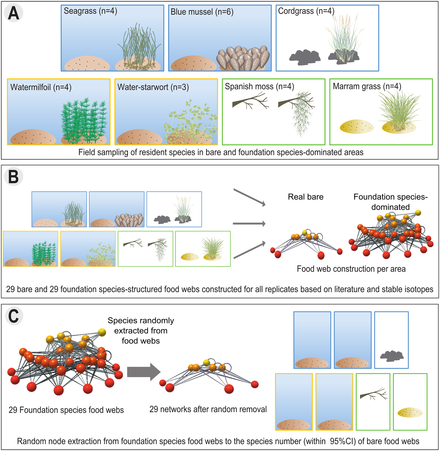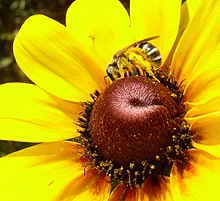Biological interaction
The biological interactions are the relationships established by organisms in a biological community within an ecosystem. Interactions can occur between individuals of different species (interspecific interactions), or between the same species (intraspecific interactions). In an ecosystem there are no organisms totally isolated from their environment. These are part of the environment, rich in non-living elements —inorganic matter— and in other organisms of the same or other species, with which they form multiple interactions. The relationships between species can be very diverse, ranging from physical fights or for resources and services (competition), to the cooperation of both species to live for mutual benefit (mutualism).
Types of biological interactions
Biological interactions are classified into 6 main ones:
Competition
Competition is a biological interaction between two living beings in which the aptitude or biological adequacy of both is reduced. Either because of direct physical attacks (interference competition) or indirectly, because they compete for the same shared resource (exploitation competition); Such a resource can be food, water, territory, partners, etc. There may be intraspecific competition when organisms of the same species compete, or interspecific when organisms of different species compete. An example of interspecific competition is Mutual Exclusion – interaction in which one species excludes another from the same habitat, and vice versa. Generally, the exclusion is made by alteration of the common habitat.
Amensalism
Amensalism is the interaction that is detrimental to one of the species and neutral to the other (neither harms nor benefits its adequacy) includes phenomena such as accidental crushing, accidental antibiosis, accidental allelopathy, among others.
Antagonism
It is the interaction in which one species benefits and another is harmed includes:
- Depredation is the interaction in which one species captures and feeds on another. The predator is usually bigger than the prey.
- Herbivory and all its forms of grazing, folivore or filophagus, frugivore, granivore, etc.
- Parasitic The parasite is usually smaller than the guest.
Neutralism
Neutralism is the interaction between two species, where neither is benefited or harmed.
Commensalism
Commensalism is an interaction in which one species is beneficial and neutral to the other, some examples include:
- Inquilinism, interaction similar to comensalism in which a species benefits from being housed while the other is not benefited or harmed.
- Facilitation is the interaction in which at least one of the species benefits. For example, parasol plants in the desert facilitate the presence of other plants that do not tolerate so much radiation under their shadow, these plants that grow below do not remove resources or space from the mother plant or vice versa.
- Epibiosis. When an organism consumes from another organism without harming it. For example the algae that grow the shell of turtles do not harm or benefit the turtle.
- Tanatocresis. When an organism benefits from a dead organism. For example the hermit crab that uses as protection the shell of a dead sea snail.
- Foresia. When an organism benefits from transporting into another organism. For example the mites that use their hosts as means of transport to reach other places.
- Syntrophy. When one agency benefits from the metabolic wastes of another. For example, microbial carpets that have metabolic routes coupled and metabolites in common that are recycled.
Mutualism
Mutualism is a biological interaction, where both individuals benefit and improve their biological fitness. It can be forced when neither of the two organisms can live without the other or optional when they are not necessarily needed to survive. Mutualism includes other phenomena such as:
- Symbiosis, the relationship between two or more species, mandatory in the long term, in which all or some of the symbionts benefit, symbiosis generates coevolution.
- Protocooperation, interaction in which two organisms or populations benefit each other, the relationship is not essential to the life of both, as they can live separately. It can be given even among organisms of different realms, as in the case of flowers and pollinators or certain plants and their mycorrizas.
Non-trophic interactions

In a 2018 Borst study et al... (A) Seven ecosystems with founding species were shown: coastal (marine saucer, blue mussel, Spartina), fresh water (milenrama of water, water-starwort) and land (Spanish moss, marram grass).
(B) Food networks were built for replicated areas dominated by founding and naked species
(C) Of each structured food network of basic species, random nodes (species) were eliminated until the number of species coincided with the number of species in the naked food networks.
It was discovered that the presence of founding species strongly increased the complexity of the food network, in particular facilitating the highest species in food chains.
Some examples of non-trophic (ie non-feeding) interactions are habitat modification, mutualism, and competition for space. It has recently been suggested that non-trophic interactions may indirectly affect food web topology and food dynamics by affecting web species and the strength of food linkages. Several recent theoretical studies have emphasized the need to integrate trophic and non-trophic interactions in ecological network analyses. The few empirical studies that address it suggest that the structures of food webs (web topologies) may be strongly influenced by the species interactions outside the trophic web. However, these studies only include a limited number of coastal systems, and it remains unclear to what extent these results can be generalized. Whether non-trophic interactions tend to affect specific species, trophic levels, or functional groups within the food web or, conversely, indiscriminately mediate species and their trophic interactions throughout the web has not yet been resolved. Some studies suggest that sessile species with generally low trophic levels seem to benefit more than others from non-trophic facilitation, while other studies suggest that facilitation benefits higher-trophic, more mobile species as well.
A 2018 study by Borst et al. tested the general hypothesis that founder species - spatially dominant habitat-shaping organisms - modify food webs by increasing their size, indicated by the number of species, and their complexity, indicated by the density of links, through species facilitation, regardless of ecosystem type (see diagram). In addition, they found that any change in the properties of the networks Trophic facilitation caused by founder species occurs through the random facilitation of species in the entire food web or through the directed facilitation of specific species belonging to certain trophic levels or functional groups. Food web base species were found to be less facilitated and carnivores more facilitated in the food webs of the founder species than predicted based on random facilitation, resulting in a higher mean trophic level. high and a greater average length of the chain. This indicates that founder species strongly increase the complexity of food webs through non-trophic facilitation of species throughout the food web.
Although founder species are part of the food web like any other species (for example, as prey or predator), numerous studies have shown that they greatly facilitate the associated community by creating a new habitat and relieving physical stress. This form of non-trophic facilitation by founder species has been found in a wide range of ecosystems and environmental conditions. In harsher coastal areas, corals, kelp, mussels, oysters, seagrass, mangroves, and marsh plants help organisms attenuate currents and waves, providing structure over soil for shelter and fixation, concentrating nutrients and/or reducing desiccation stress during low tide exposure. In more benign systems, base species such as forest trees, savannah shrubs and grasses, and macrophytes in freshwater systems have also been found to play an important structuring role in the ecosystem. habitat. Ultimately, all founder species increase the complexity and availability of habitat, thus dividing up and enhancing the niche space available to other species.
Contenido relacionado
Marine biology
Extinction
Biocoenosis
Systematic botany
Biogeographic range

